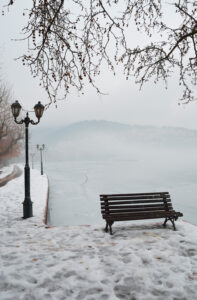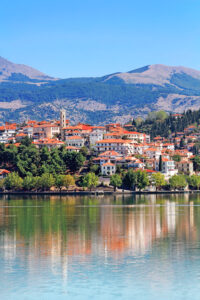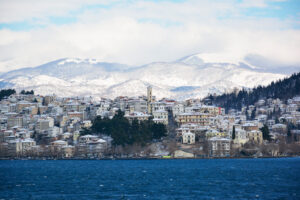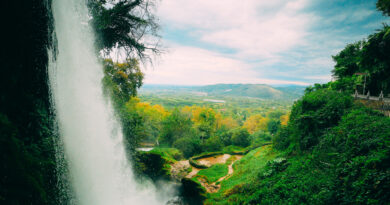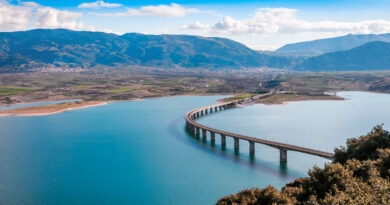Kastoria – Amazing, Ancient City Between Beautiful Lakes and Mountains
Kastoria is one of Macedonia’s most picturesque cities and is in fact regarded by the Greeks as one of the most beautiful towns in the country. It is situated on a promontory on the western shore of Lake Orestiada, in a valley surrounded by limestone mountains. The town is known for its many Byzantine churches, Ottoman-era domestic architecture, fur clothing industry, and trout.
Where is Kastoria in Greece?
Map of West Macedonia
How to reach Kastoria?
Flights to Kastoria
History of Kastoria
International fur trade centre
Greek Orthodox centre with 54 churches
Lake Kastoria – a rich wetland
Ancient Dispilio and the lakeside village
Neolithic lakeside settlement
Kastoria – Weather and climate

Where is Kastoria in Greece?
Kastoria is located in West Macedonia in northern Greece, not far from the borders to North Macedonia. It is a city located next to the lake of Osteriada in a mountainous region.
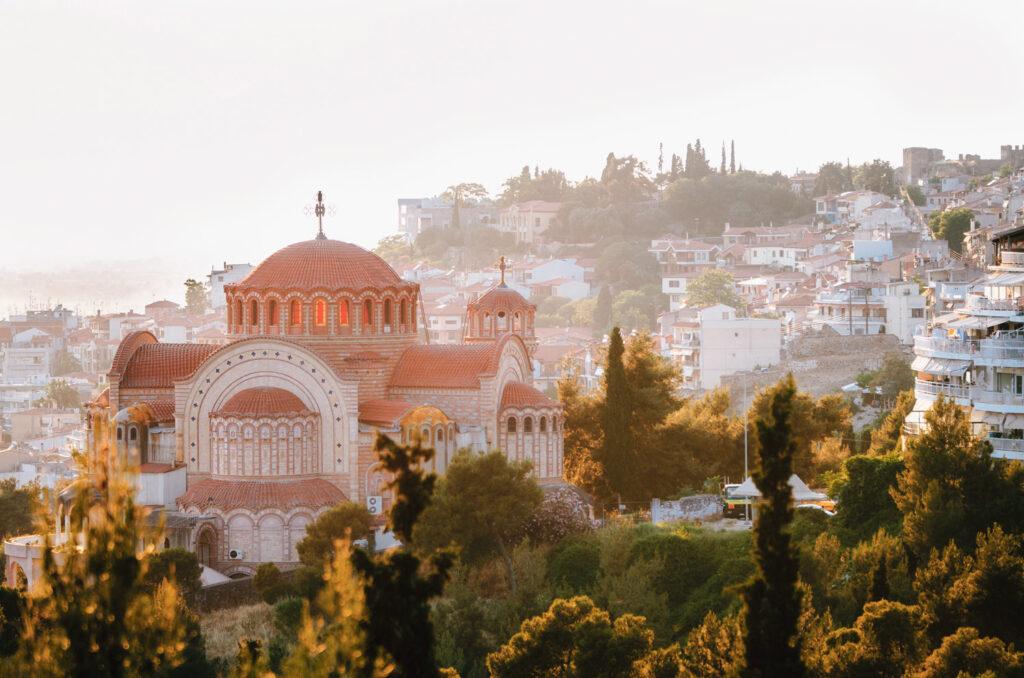
Thessaloniki Tours
TICKETS & THINGS TO DO:
Map of West Macedonia

How to reach Kastoria?
You can reach Katoria by car from Athens (through Kozani). The distance is 575 km from Athens and 219 km from Thessaloniki. You can also reach Kastoria by bus from Athens and Thessaloniki.

Flights to Kastoria
You can also choose to fly to Kastoria. The nearest airport is Argos Orestiko Airport which is located 10 km from Kastoria. Upon arrival you can either rent a car or go by taxi or bus to Kastoria city.
History of Kastoria
Kastoria is believed to have ancient origins; it has been identified with the ancient town of Celetrum, possibly located on a hill above the town’s current location, and captured by the Romans in 200 BC. The Roman Emperor Diocletian (ruled 284-305 AD) founded the town of Diocletianopolis somewhere in the vicinity.
Read more about the history of Kastoria at Wikipedia
Kastoria – International fur trade centre

Kastoria is an international centre of fur trade, which dominates the local economy. The town was possibly named after one of the former staples of the trade – the European beaver (kastóri in Greek), now extinct in the area. Trading in mink fur now predominates and every year an international showcase of fur takes place in the city. Other industries include the sale and distribution of locally grown produce, particularly wheat, apples, wine and fish. Recently a large shopping center has been built in the city of Kastoria. The town’s airport is named Aristotelis Airport.
Kastoria – Greek Orthodox centre with 54 churches
Kastoria is an important religious centre for the Greek Orthodox Church and is the seat of a metropolitan bishop. It originally had 72 Byzantine and medieval churches, of which 54 have survived, including St Athanasius of Mouzaki. Some of these have been restored and provide useful insight into trends in Late Byzantine styles of architecture and fresco painting. The Museum of Byzantine History located on Dexamenis Square houses many examples of Byzantine iconography. Kastoria is filled with old manors dating to the Ottoman period, while parts of the old Byzantine walls also stand.
Don’t miss a visit to the Kastorian Museum of Folklore housed in one of the 500 year old mansion which belonged to the wealthy Neranzis Alvazis family.
Lake Kastoria – rich wetland
Lake Kastoria is especially beautiful in autumn and spring, the best seasons to get to know the town. At various points round the lake you’ll find restaurants, tavernas, rotisseries, and cafes for gazing at the lake and reflecting on what you’ve seen. There is a 9 km road the follows the promontory and the lake is home to frogs, turtles and a great many spieces of birds.
Ancient Dispilio and the lakeside village

Dispilio is an archaeological site containing remains of a Neolithic lakeshore settlement that occupied an artificial island near the modern village of Dispilio on Lake Orestiada. The lakeside village of Dispilio is 8 km from Kastoria.
The lake settlement was discovered during the dry winter of 1932, which lowered the lake level and revealed traces of the settlement. A preliminary survey was made in 1935 by Antonios Keramopoulos. Excavations began in 1992, led by George Hourmouziadis, professor of prehistoric archaeology at the Aristotle University of Thessaloniki. The site’s paleoenvironment, botany, fishing techniques, tools and ceramics were published informally in the June 2000 issue of a Greek archaeology magazine and by Hourmouziadis in 2002.
A short distance from the exhibition area, lake, lakeside, and land dwellings have been built by the lake, all exact reconstructions of the huts of the prehistoric settlement. Inside the huts are all the utensils which the people used for their everyday needs. An earthen cover in the middle of the settlement served to protect the fire, and there is a kind of pirogue moored at the lakeside, which the inhabitants would have used for fishing.

Neolithic lakeside settlement
The site appears to have been occupied over a long period, from the final stages of the Middle Neolithic (5600-5000 BC) to the Final Neolithic (3000 BC). A number of items were found, including ceramics, wooden structural elements, seeds, bones, figurines, personal ornaments, flutes (one of them dating back to the 6th millennium BCE, the oldest ever found in Europe) and what appears to be the most significant finding, the inscribed Dispilio Tablet. (Excavations official website)
Lakeside area, Dispilio, Kastoria prefecture, Macedonia, Greece
Opening hours: Winter period: 9:00 – 14:30
Summer period: 9:00 – 14:00 & 17:00 – 20:00

Macedonia Tours
TICKETS & THINGS TO DO:
Kastoria – Weather and climate
In Kastoria the hottest month is July with an average temperature of 21.5°C (71°F). January is the coldest at 2.5°C (37°F) and June is the month with the most daily sunshine of 10 hours. November is the rainiest month of the year with an average of 90 mm.
| April | May | June | July | August | September | October | |
|---|---|---|---|---|---|---|---|
| Day | 16° | 21° | 26° | 29° | 29° | 26° | 19° |
| Night | 5° | 8° | 12° | 14° | 14° | 11° | 7° |
| Rainfall (days) | 8 | 7 | 3 | 3 | 2 | 5 | 7 |


